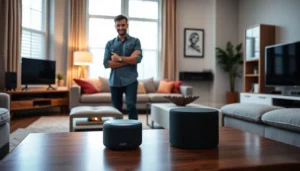Table of Contents
ToggleIn today’s tech-savvy world, juggling multiple devices feels like a modern circus act. From smartphones to tablets and smart home gadgets, it’s a wonder anyone manages to keep their sanity intact. Multi-device integration isn’t just a fancy buzzword; it’s the secret sauce that turns chaos into harmony. Imagine effortlessly switching from your laptop to your tablet without missing a beat—sounds dreamy, right?
Overview of Multi Device Integration
Multi-device integration streamlines the user experience across various devices, facilitating effortless transitions between them. It plays a crucial role in ensuring that technology enhances daily tasks rather than complicating them.
Definition and Importance
Multi-device integration refers to the connection and communication among multiple devices, enabling them to work together seamlessly. This approach is essential because it improves efficiency and productivity. Users can share information, synchronize applications, and manage tasks without hassle. According to a report by Statista, 54% of users access data across three or more devices daily, underscoring the growing need for cohesive integration.
Key Components
Key components of multi-device integration include cloud services, APIs, and synchronization protocols. Cloud services allow access to data from any connected device, while APIs facilitate communication between applications. Synchronization protocols ensure that information remains updated across devices, maintaining consistency. Additionally, a user-friendly interface enhances the overall experience, allowing for easier navigation. Each component cooperates to provide a holistic solution for managing multiple devices effectively.
Benefits of Multi Device Integration

Multi-device integration offers several key benefits that enhance productivity and user satisfaction. Users experience smoother transitions among devices with increased connectivity and communication.
Enhanced User Experience
A unified interface leads to a more intuitive experience across devices. Users can access their files, applications, and settings seamlessly, whether on a laptop or tablet. Additionally, synchronization of data updates provides real-time access, improving convenience. When notifications are consistent across devices, they encourage efficient task management. With 54% of users accessing data on three or more devices daily, this cohesion significantly enhances user engagement, promoting a more connected lifestyle.
Increased Efficiency
Efficiency rises as integrated systems streamline workflows. Users save time when they switch between tasks without the need to manually transfer information. Compatibility between applications means less disruption during work processes. Moreover, reliable cloud services allow for easy access to documents and tools from any location. Employees demonstrate a noticeable increase in productivity when devices communicate effectively. As daily tasks simplify, stress decreases, resulting in higher overall satisfaction.
Challenges in Multi Device Integration
Multi-device integration presents significant challenges that users face in maintaining efficiency and security. Compatibility and data security are two primary areas of concern.
Compatibility Issues
Compatibility issues arise when different devices and operating systems do not communicate effectively. Users often encounter difficulties when trying to connect various brands or versions of devices. Cross-platform applications may not function consistently, leading to frustration. Devices that support different protocols can make seamless integration difficult. Proper testing and updates play crucial roles in addressing these disparities. As devices evolve, ensuring compatibility remains a top priority for manufacturers and developers.
Data Security Concerns
Data security concerns increase with multi-device integration due to the complexity of interconnected systems. Sensitive information often travels across multiple platforms, amplifying the risk of breaches. Encryption becomes essential for protecting data during transmission. Users must adopt stringent security measures to safeguard their information. Adopting best practices, such as strong passwords and multi-factor authentication, is vital. Companies need to prioritize robust cybersecurity strategies to mitigate risks associated with potential vulnerabilities.
Best Practices for Implementing Multi Device Integration
Implementing multi-device integration requires thoughtful consideration and strategic choices. Organizations must prioritize effective technologies to establish robust integrations and ensure seamless communication.
Choosing the Right Technologies
Selecting appropriate technologies lays the foundation for successful integration. Organizations should consider cloud services, APIs, and synchronization protocols as core components. Cloud services enable flexible data access from any location, enhancing productivity. APIs facilitate interactions between devices and applications, allowing them to share data effortlessly. Synchronization protocols ensure that information remains up to date across multiple devices, which is critical for user satisfaction. Additionally, evaluating compatibility with existing systems prevents potential issues during implementation. Security features must also be a priority, as they safeguard sensitive information. The combination of these elements creates a reliable integration environment.
Ensuring Seamless Communication
Establishing seamless communication among devices enhances the overall user experience. Effective communication channels improve data flow and synchronization. Notifications should be consistent across all devices, allowing users to remain informed regardless of which device they are using. It’s important to invest in reliable protocols that support real-time data exchange. Regular updates on software and security help maintain smooth interactions between devices. Testing systems under various scenarios helps identify and resolve potential issues before they affect users. Prioritizing robust communication contributes to a cohesive multi-device environment that boosts efficiency and user engagement.
Future Trends in Multi Device Integration
Multi-device integration is evolving rapidly, driven by technological advances. Anticipating future trends can help users prepare for changes in their device interactions.
Emerging Technologies
Artificial intelligence significantly enhances multi-device integration. AI algorithms provide personalized experiences by learning user behavior and preferences. Edge computing also plays a crucial role, reducing latency and improving response times across devices. Blockchain technology strengthens data security in integrated systems, protecting sensitive information against breaches. Moreover, the Internet of Things (IoT) continues to expand connectivity, allowing devices to communicate seamlessly. Users can expect these technologies to create more cohesive and responsive device ecosystems.
Predictions for the Next Decade
The next decade will likely see an increase in device interoperability. As more manufacturers adopt universal standards, seamless communication among devices improves. Users will experience significantly enhanced services due to ongoing advancements in cloud computing, enabling access to data from various locations effortlessly. Predictive analytics will likely offer proactive solutions, anticipating user needs and improving workflows. Greater emphasis on privacy will prompt organizations to integrate robust security measures across devices. Ultimately, these developments will foster a more interconnected digital experience, enhancing convenience and productivity across user environments.
Embracing multi-device integration is essential for navigating today’s fast-paced digital landscape. By prioritizing seamless connectivity and user-friendly interfaces, individuals and organizations can significantly enhance productivity and satisfaction. As technology continues to evolve, the focus on compatibility and robust security measures will only grow in importance.
Future advancements promise even greater interoperability among devices, paving the way for a more cohesive user experience. With the right strategies in place, users can enjoy the benefits of an integrated environment that simplifies tasks and fosters efficiency. Ultimately, investing in multi-device integration is a step towards a more connected and productive future.




